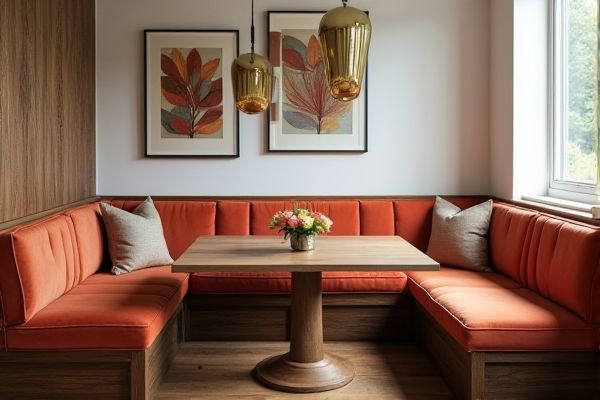
Bench seating offers a versatile and space-saving option that can accommodate multiple people, making it ideal for casual dining or social gatherings. Discover how choosing between bench seating and banquette can transform your dining space by reading the rest of the article.
Table of Comparison
| Feature | Bench Seating | Banquette |
|---|---|---|
| Design | Long, backless or low-back seating, usually movable | Built-in or fixed seating with backrest, often upholstered |
| Space Efficiency | Flexible seating, suitable for variable group sizes | Maximizes corner and wall space, ideal for tight areas |
| Comfort | Generally less comfortable; back support varies | More comfortable with padded backrests and cushions |
| Style | Casual, versatile for indoor and outdoor use | Elegant, enhances interior design and ambiance |
| Maintenance | Easy to clean and move | Requires fixed cleaning approach; upholstery may need care |
| Installation | No installation needed; portable | Requires custom build or installation |
| Typical Use | Casual dining, outdoor patios, picnic areas | Restaurants, cafes, formal dining spaces |
Introduction to Bench Seating and Banquette
Bench seating offers a versatile and space-efficient option commonly used in dining areas, providing continuous seating that maximizes capacity and encourages social interaction. Banquettes are built-in upholstered seats often integrated into corners or walls, combining comfort with a sleek design ideal for both residential and commercial settings. Both seating styles enhance space utilization but differ in structural design and aesthetic appeal, catering to various interior layouts and user preferences.
Defining Bench Seating: Key Features
Bench seating features a long, continuous seat designed to accommodate multiple people, often found in casual dining or outdoor spaces. Its minimalist design typically lacks a backrest or cushions, emphasizing simplicity and space efficiency. Your choice of bench seating can enhance flexibility in seating arrangements and optimize room layout.
What Is a Banquette? Distinctive Characteristics
A banquette is a built-in upholstered seating area commonly found in restaurants and homes, designed to maximize space efficiency and provide comfortable, fixed seating. Its distinctive characteristics include a continuous backrest, often positioned against a wall, and a custom-fit design that seamlessly integrates with tables and room layouts. You benefit from the cozy, space-saving nature of banquettes, which contrast with movable bench seating typically more versatile but less integrated.
Space Efficiency: Bench Seating vs. Banquette
Bench seating maximizes space efficiency by accommodating more people in a linear arrangement, making it ideal for narrow or compact areas. Banquette seating offers optimized use of corner or wall spaces with built-in cushioning, providing both comfort and storage options beneath the seats. Choosing between bench and banquette seating depends on room dimensions, desired capacity, and the need for multifunctional furniture elements.
Comfort and Ergonomics Comparison
Bench seating offers a flexible, spacious option that can accommodate varying body sizes but may lack individual back support, impacting long-term comfort. Banquette seating provides ergonomic advantages with built-in backrests and cushioned surfaces, promoting better posture and reducing fatigue during extended use. Your choice between bench and banquette should consider the balance between open seating space and the need for personalized support to enhance comfort.
Design Flexibility and Customization Options
Bench seating offers greater design flexibility with its modular nature, allowing for easy rearrangement and customization to fit various spaces and styles. Banquettes provide built-in seating that can be tailored with upholstery, cushions, and tailored finishes, enhancing comfort and aesthetic appeal in a fixed spot. Your choice depends on whether you need adaptable configurations or a cohesive, permanent seating solution.
Installation and Cost Considerations
Bench seating typically requires less material and simpler framing, resulting in lower installation costs compared to banquettes, which often involve built-in cabinetry and custom upholstery. Installation time for bench seating is generally shorter, reducing labor expenses, while banquettes may require professional carpentry and precise measurements to fit seamlessly into a space. Cost considerations should factor in long-term durability and maintenance, with benches often being more cost-effective for budget-conscious projects.
Best Applications: Where Each Option Shines
Bench seating excels in casual dining environments such as cafes and family restaurants due to its space-efficient design and flexibility for accommodating varying group sizes. Banquettes are ideal for upscale dining rooms or lounges, offering a stylish, cozy ambiance complete with upholstery that enhances comfort and visual appeal. Choosing between the two depends on the desired atmosphere, seating capacity, and spatial constraints of the venue.
Maintenance and Durability Differences
Bench seating typically requires less maintenance due to its simple design and fewer crevices where dirt can accumulate, making it easier to clean. Banquettes, often upholstered and cushioned, may demand more frequent maintenance such as vacuuming and spot cleaning to preserve fabric integrity and prevent wear. Your choice hinges on balancing the maintenance efforts with desired durability, as benches often outlast banquettes in high-traffic settings due to their sturdy construction.
Conclusion: Choosing the Ideal Seating Solution
Bench seating offers versatile, space-saving designs ideal for casual and high-traffic areas, while banquettes provide a cozy, fixed seating option that enhances comfort and style in dining spaces. Consider the room size, intended use, and aesthetic preferences to determine which option best maximizes functionality and ambiance. Opting for bench seating suits flexibility and communal environments, whereas banquettes elevate a more intimate and structured dining experience.
 homyna.com
homyna.com